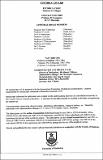| dc.contributor.author | Matchaba-Hove, R.B | |
| dc.contributor.author | Siziya, S. | |
| dc.contributor.author | Rusakaniko, S. | |
| dc.contributor.author | Kadenhe, R.M. | |
| dc.contributor.author | Dumbu, S. | |
| dc.contributor.author | Chirenda, J. | |
| dc.coverage.spatial | Zimbabwe | en_GB |
| dc.date.accessioned | 2014-10-30T12:01:53Z | |
| dc.date.available | 2014-10-30T12:01:53Z | |
| dc.date.issued | 2001-09 | |
| dc.identifier.citation | Matchaba-Hove, R.B. et al. (2001) Mercury poisoning: prevalence, knowledge and frequency of gold panning and doing retort among alluvial gold panners in Chiweshe and Tafuna communal lands in Zimbabwe, CAJM Vol. 49, no. 9. Harare, Avondale: CAJM. | en_GB |
| dc.identifier.issn | 0008-9176 | |
| dc.identifier.uri | https://opendocs.ids.ac.uk/opendocs/handle/20.500.12413/4927 | |
| dc.description | A CAJM journal article. | en_GB |
| dc.description.abstract | Objectives: To estimate the prevalence of mercury poisoning, to estimate the knowledge level that mercury can be a poison, and to establish the frequency of gold panning and doing retorts.
Design: Cross sectional study.
Setting: Chiweshe and Tafuna communal lands.
Subjects: Gold panners.
Main Outcome Measure: Mercury levels in blood and urine.
Results: Totals of 23 respondents from Chiweshe and 43 respondents from Tafuna were recruited. Four out of 43 respondents in Tafuna and seven out of 23 respondents in Chiweshe had levels of mercury greater than 0.05 mg/L in blood (p=0.040). Out of 43 respondents in Tafuna, four (9.3%) had levels of mercury of more than 0.01 mg/L in urine. Totals of 18 out of 37 and seveil out of 22 respondents from Tafuna and Chiweshe, respectively, did not know that mercury could be a poison. Altogether, 35 (56.5%) out of 62 respondents were full time gold panners. Significantly more respondents in Chiweshe (14/19) than in Tafuna (8/29) did less than four retorts per month (p=0.005). Respondents who did four or more retorts per month were 3.21 (95%CI 1.06 to 9.72) times more likely to have had raised levels of mercury in their blood compared with persons who did less than four retorts per month.
Conclusion: Mercury poisoning among gold panners in Chiweshe and Tafuna communal lands is of public health importance. Panners should be educated on the possibilities of mercury being a poison. A low cost and safe technology to separating mercury from the amalgam should be introduced to the panners. | en_GB |
| dc.language.iso | en | en_GB |
| dc.publisher | Central African Journal of Medicine (CAJM), University of Zimbabwe | en_GB |
| dc.rights.uri | http://creativecommons.org/licenses/by-nc-nd/3.0/ | en_GB |
| dc.subject | Health | en_GB |
| dc.title | Mercury poisoning: prevalence, knowledge and frequency of gold panning and doing retort among alluvial gold panners in Chiweshe and Tafuna communal lands in Zimbabwe | en_GB |
| dc.type | Article | en_GB |
| dc.rights.holder | University of Zimbabwe | en_GB |


